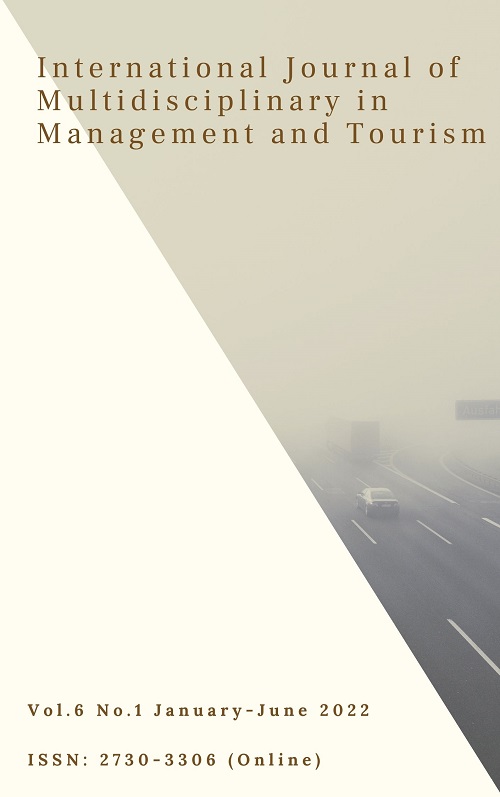The Value of “Tha Non Kon Dern” Walking Street as a Space to Enhance Tourism in Nakhon Phanom Province
Main Article Content
Abstract
Walking street has become a part of the social value for locals and tourists. The image of the walking street will be changed as the space becomes more modernized to attract tourists. This article aims to study (1) the physical of the walking Street setting for the zone (2) to assess the existing qualities of the walking Street as a social space for tourists. On the characteristics of tourists, data was obtained from 400 randomly selected respondents. Content analysis and descriptive statistics are used to analyze data. The following are the findings of the study:
1. The Walking Street is located on Main Street in the heart of the city, beside the Maekhong River. From Friday to Saturday, from 5.00 p.m. to 10.00 p.m., a traditional market selling a variety of home things is held. The setting up of tents by the merchants who normally sell garments and accessories on the street from evening to late at night was spotted on the south areas of the street. Five zones were created in the walking street area.
2. In terms of physical setting and landscape setting, the tourists agreed that the "Tha Non Kon Dern" Walking Street provided a wonderful experience. There appears to be a clear link between the physical setting and the landscape setting, with the site context area supporting the majority of leisure or social activities. The Walking Street itself is located by Mekhong River, which is surrounded by an old buldging historical site. Instead of only having social interaction between sellers and tourists, the Walking Street creates locations for tourists to sit and pause, allowing people to socialize, watch and listen to other people, or enjoy the sight, sound, and scent.
Article Details

This work is licensed under a Creative Commons Attribution-NonCommercial-NoDerivatives 4.0 International License.
References
Abrahale, K., Sousa, S., Albuquerque, G., Padrão, P., & Lunet, N. (2019). Street food research worldwide: a scoping review. Journal of Human Nutrition and Dietetics, 32(2), 152-174.
An, S., Choi, Y., & Lee, C. K. (2021). Virtual travel experience and destination marketing: effects of sense and information quality on flow and visit intention. Journal of Destination Marketing & Management, 19, 100492.
Carmona, M. (2021). Public places urban spaces: The dimensions of urban design. Routledge.
De Marchi, V., Di Maria, E., & Gereffi, G. (2018). Local clusters in global value chains. Routledge.
Evans, G. (2019). Contemporary crafts as souvenirs, artefacts and functional goods and their role in local economic diversification and cultural development (pp. 127-146). Routledge.
Farhan, H., & Anwar, K. (2016). The tourism development strategy based on rural and local wisdom. Journal of Sustainable Development, 9(3), 170-181.
Kingkan, P. (2014). Community-Based Destination Sustainable Development: Case of Cicada Walking Street, Hua Hin, Thailand. International Journal of Economics and Management Engineering, 8(6), 1957-1962.
Mateo-Babiano, I. B., & Ieda, H. (2007). Street space sustainability in Asia: The role of the Asian pedestrian and street culture. In Proceedings of the Eastern Asia Society for Transportation Studies Vol. 6 (The 7th International Conference of Eastern Asia Society for Transportation Studies, 2007) (pp. 242-242). Eastern Asia Society for Transportation Studies.
Mumford, L. (2016). The culture of cities (Vol. 19). Open Road Media.
Pandey, P., & Pandey, M. M. (2015). Research Methodology Tools and Techniques. Bridge Center.
Sekhani, R., Mohan, D., & Medipally, S. (2019). Street vending in urban 'informal markets: Reflections from case-studies of street vendors in Delhi (India) and Phnom Penh City (Cambodia). Cities, 89, 120-129.
Suwanvijit, W. (2016). Attitudes Toward Cultural Tourism with Community Participation: A Case Of ‘Authentic Songkhla Food Old-Time Atmosphere’ Walking Street in Southern Thailand. Organizational Studies and Innovation Review, 2(1), 8-14.
Thailandometers. (2016). Thailandometers: Statistics of Thailand updated by real-time Retrieved from http://www.thailandometers.Mahidol.ac.th/index.PHP?#population.
Zhang, T., Chen, J., & Hu, B. (2019). Authenticity, quality, and loyalty: Local food and sustainable tourism experience. Sustainability, 11(12), 3437.
Zhu, D., Song, Z., & He, J. (2020, July). Duolun Road Cultural Street: Research on Cultural and Creative Products Using User Portraits. In International Conference on Applied Human Factors and Ergonomics (pp. 430-436). Springer.

